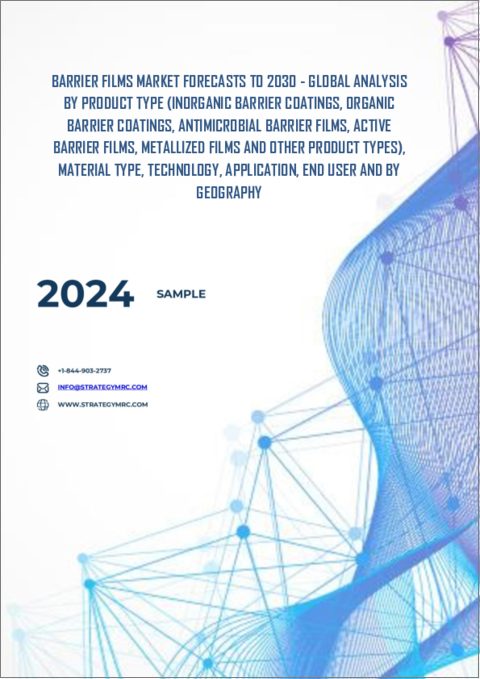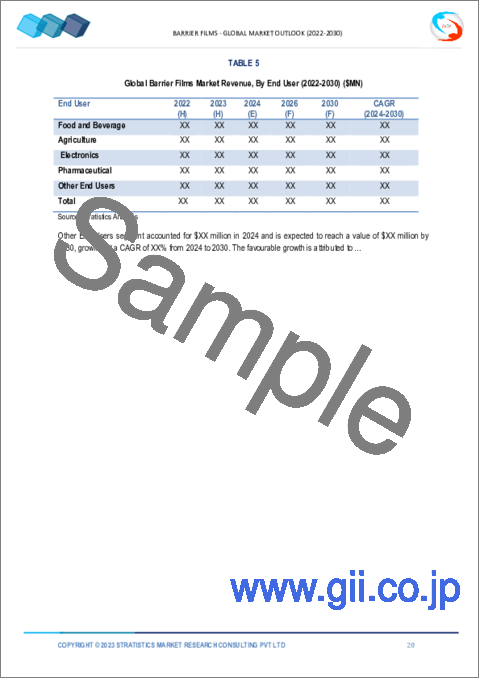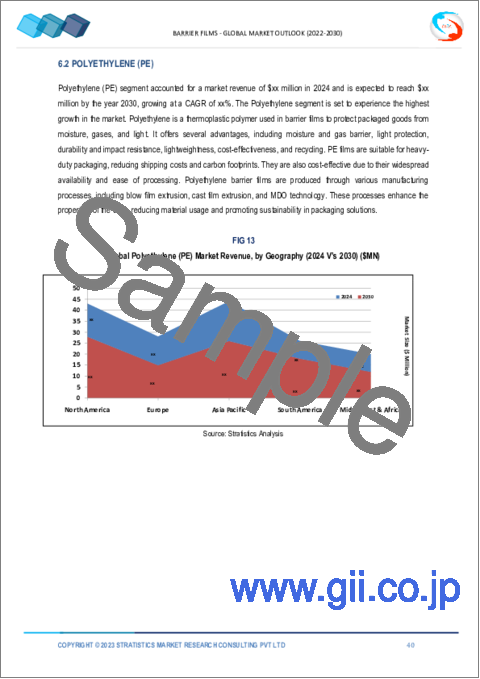|
|
市場調査レポート
商品コード
1494893
バリアフィルム市場の2030年までの予測:製品タイプ、材料タイプ、技術、用途、エンドユーザー、地域別の世界分析Barrier Films Market Forecasts to 2030 - Global Analysis By Product Type, Material Type, Technology, Application, End User and By Geography |
||||||
カスタマイズ可能
|
|||||||
| バリアフィルム市場の2030年までの予測:製品タイプ、材料タイプ、技術、用途、エンドユーザー、地域別の世界分析 |
|
出版日: 2024年06月06日
発行: Stratistics Market Research Consulting
ページ情報: 英文 200+ Pages
納期: 2~3営業日
|
全表示
- 概要
- 図表
- 目次
Stratistics MRCによると、バリアフィルムの世界市場は2024年に367億米ドルを占め、予測期間中にCAGR 7.7%で成長し、2030年には573億米ドルに達すると予想されています。
バリアフィルムは、湿気、酸素、光、香りなどの外部要素に対して保護バリアを提供するように設計された特殊な包装材料です。これらのフィルムは、食品包装、医薬品、電子機器など、製品の完全性を保つことが重要な産業で一般的に使用されています。バリアフィルムは、生鮮品の保存期間を延ばし、製品の鮮度を保ち、汚染や腐敗を防ぐのに役立ちます。バリアフィルムは通常、プラスチックポリマー、アルミ箔、金属蒸着フィルムなど様々な素材から作られており、バリア性を高めるために多層構造になっていることが多いです。
便利な食品包装への需要の高まり
市場は、便利な食品包装ソリューションへの嗜好の高まりによって需要が急増しています。消費者は、製品の保存性を高めると同時に、取り扱いや保管が容易な包装を求めるようになっています。バリアフィルムは、湿気、酸素、光などの外的要因から内容物を保護することで、効果的なソリューションを提供します。このような需要の高まりは、製品の鮮度と利便性の両方を保証する包装の重要性を浮き彫りにし、市場の成長を促進しています。
環境への配慮
従来のプラスチックフィルムは環境に悪影響を与えるため、消費者は環境に優しい代替品を求めるようになっています。こうした要求に応えるには、生分解性フィルム、リサイクル可能な素材、包装廃棄物の削減といった革新的なアプローチが必要です。しかし、持続可能性と性能および費用対効果のバランスをとることは、メーカーにとって依然としてハードルとなっています。規制の圧力、消費者の嗜好の変化、サプライチェーン全体での持続可能な実践の必要性は、市場における環境問題への取り組みという課題をさらに複雑にしています。
硬質包装から軟質包装へのシフト
市場では、硬質包装から軟質包装への移行が顕著です。この移行は、利便性、軽量化、持続可能なパッケージング・ソリューションに対する消費者の需要など、いくつかの要因によって推進されています。軟包装はデザインに多様性をもたらし、メーカーが製品の完全性を維持し賞味期限を延ばしながら革新的なパッケージング・ソリューションを生み出すことを可能にします。さらに、その費用対効果の高さと環境への影響の低減により、進化する市場の要求と持続可能性の目標に対応することを目指す企業にとって、魅力的な選択肢となっています。
原材料の高コスト
同市場は、原材料費の高騰による大きな課題に直面しています。この阻害要因は、石油価格の変動、特殊ポリマーの不足、高度なバリア材料に対する需要の増加など、さまざまな要因に起因しています。その結果、メーカーは製品の品質を確保しながら競争力のある価格設定を維持することが困難になっています。戦略的調達、材料効率化のための技術革新、サプライチェーンの最適化などの緩和戦略は、この課題を乗り切り、市場の成長を維持するために不可欠です。
COVID-19の影響:
COVID-19の流行はバリアフィルム市場に大きな影響を与え、世界サプライチェーンと製造プロセスに混乱を引き起こしました。需要の変動、供給不足、ロジスティクスの課題が業界に障害をもたらしました。しかし、市場はまた、衛生と安全対策に対する意識の高まりにより、特に食品とヘルスケア分野における包装用途でのバリアフィルム需要の急増を示した。パンデミックは抗菌特性を持つバリアフィルムの採用を加速させ、進化する消費者ニーズに対応するための市場の技術革新を促進しました。
予測期間中、多層フィルム分野が最大となる見込み
予測期間中、多層フィルムが最大となる見込み。多層フィルムはバリアフィルム市場の極めて重要な構成要素であり、環境要因からの保護強化を提供します。これらのフィルムは、それぞれ独自のバリア特性を持つ異なる素材の複数の層で設計されています。この革新的な設計により、包装された商品の優れた保存性が保証され、賞味期限が延長され、製品の完全性が維持されます。食品包装、医薬品、電子機器など様々な産業で需要が高まる中、多層フィルムは製品の品質と安全性を確保する上で重要な役割を果たしています。
可塑剤分野は予測期間中に最も高いCAGRが見込まれる
可塑剤分野は、予測期間中に最も高いCAGRが見込まれます。柔軟性を維持しながらバリア特性を高めることに重点を置く可塑剤は、フィルムの性能を最適化する上で重要な役割を果たしています。材料科学の先進化により、食品包装や電子機器など特定の用途ニーズに合わせた革新的な可塑剤が開発されています。持続可能性が注目される中、バイオベースや環境に優しい可塑剤の採用が拡大しており、市場の様相が変わりつつあります。
最大のシェアを占める地域
北米は、食品包装、医薬品、電子機器など様々な産業からの需要増加により、予測期間中最大の市場シェアを占めると予測されます。これらのフィルムは湿気、酸素、その他の外的要因から優れた保護を提供し、製品の保存期間を延ばし、品質を維持します。バリアフィルム材料の技術的進歩と革新は、その性能と持続可能性をさらに高めています。利便性と持続可能性に重点を置くことで、この地域の市場は継続的に拡大する態勢を整えています。
CAGRが最も高い地域:
アジア太平洋地域は、包装食品需要の増加、食品の安全性に関する意識の高まり、医薬品産業やエレクトロニクス産業の成長などの要因によって、予測期間中に最も高いCAGRを維持すると予測されます。これらの国々には大規模な消費者基盤があり、経済も成長しているため、包装商品の需要が高まっています。さらに、利便性と持続可能性に焦点が当てられていることから、同地域の市場は継続的に拡大する態勢を整えています。
無料カスタマイズサービス:
本レポートをご購読のお客様には、以下の無料カスタマイズオプションのいずれかをご利用いただけます:
- 企業プロファイル
- 追加市場プレイヤーの包括的プロファイリング(3社まで)
- 主要企業のSWOT分析(3社まで)
- 地域セグメンテーション
- 顧客の関心に応じた主要国の市場推計・予測・CAGR(注:フィージビリティチェックによる)
- 競合ベンチマーキング
- 製品ポートフォリオ、地理的プレゼンス、戦略的提携に基づく主要企業のベンチマーキング
目次
第1章 エグゼクティブサマリー
第2章 序文
- 概要
- ステークホルダー
- 調査範囲
- 調査手法
- データマイニング
- データ分析
- データ検証
- 調査アプローチ
- 調査情報源
- 1次調査情報源
- 2次調査情報源
- 前提条件
第3章 市場動向分析
- 促進要因
- 抑制要因
- 機会
- 脅威
- 製品分析
- 技術分析
- 用途分析
- エンドユーザー分析
- 新興市場
- COVID-19の影響
第4章 ポーターのファイブフォース分析
- 供給企業の交渉力
- 買い手の交渉力
- 代替品の脅威
- 新規参入業者の脅威
- 競争企業間の敵対関係
第5章 世界のバリアフィルム市場:製品タイプ別
- 無機バリアコーティング
- 有機バリアコーティング
- 抗菌バリアフィルム
- アクティブバリアフィルム
- 金属化フィルム
- その他の製品タイプ
第6章 世界のバリアフィルム市場:材料タイプ別
- ポリエチレン(PE)
- ポリプロピレン(PP)
- ポリ塩化ビニリデン(PVDC)
- ポリエチレンテレフタレート(PET)
- エチレンビニルアルコール(EVOH)
- その他の材料タイプ
第7章 世界のバリアフィルム市場:技術別
- 多層フィルム
- 共押出フィルム
- ラミネーション
- 真空蒸着フィルム
- その他の技術
第8章 世界のバリアフィルム市場:用途別
- ファインケミカル
- 可塑剤
- 油田化学薬品
- 潤滑剤
- 界面活性剤
- その他の用途
第9章 世界のバリアフィルム市場:エンドユーザー別
- 食品および飲料
- 農業
- エレクトロニクス
- 製薬
- その他のエンドユーザー
第10章 世界のバリアフィルム市場:地域別
- 北米
- 米国
- カナダ
- メキシコ
- 欧州
- ドイツ
- 英国
- イタリア
- フランス
- スペイン
- その他欧州
- アジア太平洋地域
- 日本
- 中国
- インド
- オーストラリア
- ニュージーランド
- 韓国
- その他アジア太平洋地域
- 南米
- アルゼンチン
- ブラジル
- チリ
- その他南米
- 中東・アフリカ
- サウジアラビア
- アラブ首長国連邦
- カタール
- 南アフリカ
- その他中東とアフリカ
第11章 主な発展
- 契約、パートナーシップ、コラボレーション、合弁事業
- 買収と合併
- 新製品発売
- 事業拡大
- その他の主要戦略
第12章 企業プロファイリング
- Amcor plc
- Berry Global, Inc.
- Sealed Air Corporation
- Mitsubishi Chemical Corporation
- Toppan Printing Co., Ltd.
- Toray Industries, Inc.
- Winpak Ltd.
- Mondi plc
- Uflex Ltd.
- Jindal Poly Films Ltd.
- Cosmo Films Ltd.
- Taghleef Industries LLC
- Huhtamaki Group
- 3M Company
- Nitto Denko Corporation
- Ester Industries Limited
- Futamura Chemical Co., Ltd.
List of Tables
- Table 1 Global Barrier Films Market Outlook, By Region (2022-2030) ($MN)
- Table 2 Global Barrier Films Market Outlook, By Product Type (2022-2030) ($MN)
- Table 3 Global Barrier Films Market Outlook, By Inorganic Barrier Coatings (2022-2030) ($MN)
- Table 4 Global Barrier Films Market Outlook, By Organic Barrier Coatings (2022-2030) ($MN)
- Table 5 Global Barrier Films Market Outlook, By Antimicrobial Barrier Films (2022-2030) ($MN)
- Table 6 Global Barrier Films Market Outlook, By Active Barrier Films (2022-2030) ($MN)
- Table 7 Global Barrier Films Market Outlook, By Metallized Films (2022-2030) ($MN)
- Table 8 Global Barrier Films Market Outlook, By Other Product Types (2022-2030) ($MN)
- Table 9 Global Barrier Films Market Outlook, By Material Type (2022-2030) ($MN)
- Table 10 Global Barrier Films Market Outlook, By Polyethylene (PE) (2022-2030) ($MN)
- Table 11 Global Barrier Films Market Outlook, By Polypropylene (PP) (2022-2030) ($MN)
- Table 12 Global Barrier Films Market Outlook, By Polyvinylidene Chloride (PVDC) (2022-2030) ($MN)
- Table 13 Global Barrier Films Market Outlook, By Polyethylene Terephthalate (PET) (2022-2030) ($MN)
- Table 14 Global Barrier Films Market Outlook, By Ethylene Vinyl Alcohol (EVOH) (2022-2030) ($MN)
- Table 15 Global Barrier Films Market Outlook, By Other Material Types (2022-2030) ($MN)
- Table 16 Global Barrier Films Market Outlook, By Technology (2022-2030) ($MN)
- Table 17 Global Barrier Films Market Outlook, By Multilayer Films (2022-2030) ($MN)
- Table 18 Global Barrier Films Market Outlook, By Coextruded Films (2022-2030) ($MN)
- Table 19 Global Barrier Films Market Outlook, By Lamination (2022-2030) ($MN)
- Table 20 Global Barrier Films Market Outlook, By Vacuum Metallized Films (2022-2030) ($MN)
- Table 21 Global Barrier Films Market Outlook, By Other Technologies (2022-2030) ($MN)
- Table 22 Global Barrier Films Market Outlook, By Application (2022-2030) ($MN)
- Table 23 Global Barrier Films Market Outlook, By Fine Chemicals (2022-2030) ($MN)
- Table 24 Global Barrier Films Market Outlook, By Plasticizer (2022-2030) ($MN)
- Table 25 Global Barrier Films Market Outlook, By Oil Field Chemicals (2022-2030) ($MN)
- Table 26 Global Barrier Films Market Outlook, By Lubricants (2022-2030) ($MN)
- Table 27 Global Barrier Films Market Outlook, By Surfactants (2022-2030) ($MN)
- Table 28 Global Barrier Films Market Outlook, By Other Applications (2022-2030) ($MN)
- Table 29 Global Barrier Films Market Outlook, By End User (2022-2030) ($MN)
- Table 30 Global Barrier Films Market Outlook, By Food and Beverage (2022-2030) ($MN)
- Table 31 Global Barrier Films Market Outlook, By Agriculture (2022-2030) ($MN)
- Table 32 Global Barrier Films Market Outlook, By Electronics (2022-2030) ($MN)
- Table 33 Global Barrier Films Market Outlook, By Pharmaceutical (2022-2030) ($MN)
- Table 34 Global Barrier Films Market Outlook, By Other End Users (2022-2030) ($MN)
Note: Tables for North America, Europe, APAC, South America, and Middle East & Africa Regions are also represented in the same manner as above.
According to Stratistics MRC, the Global Barrier Films Market is accounted for $36.7 billion in 2024 and is expected to reach $57.3 billion by 2030 growing at a CAGR of 7.7% during the forecast period. Barrier films are specialized packaging materials designed to provide a protective barrier against external elements such as moisture, oxygen, light, and aroma. These films are commonly used in food packaging, pharmaceuticals, electronics, and other industries where preserving product integrity is crucial. Barrier films help extend the shelf life of perishable goods, maintain product freshness, and prevent contamination or spoilage. They are typically made from various materials such as plastic polymers, aluminum foil, and metallized films, often in multi-layered structures to enhance their barrier properties.
Market Dynamics:
Driver:
Rising demand for convenient food packaging
The market is experiencing a surge in demand driven by the growing preference for convenient food packaging solutions. Consumers are increasingly seeking packaging that enhances product shelf life while offering easy handling and storage. Barrier films provide an effective solution by protecting contents from external factors such as moisture, oxygen, and light. This rising demand underscores the importance of packaging that ensures both product freshness and convenience, driving growth in the market.
Restraint:
Environmental concerns
Consumers increasingly demand eco-friendly alternatives to traditional plastic films due to their adverse environmental impact. Meeting these demands requires innovative approaches such as biodegradable films, recyclable materials, and reduced packaging waste. However, balancing sustainability with performance and cost-effectiveness remains a hurdle for manufacturers. Regulatory pressures, shifting consumer preferences, and the need for sustainable practices throughout the supply chain further complicate the challenge of addressing environmental concerns in the market.
Opportunity:
Shift from rigid to flexible packaging
In the market, there's a notable transition from rigid to flexible packaging. This shift is driven by several factors, including consumer demand for convenience, lightweight, and sustainable packaging solutions. Flexible packaging offers versatility in design, enabling manufacturers to create innovative packaging solutions while maintaining product integrity and extending shelf life. Moreover, its cost-effectiveness and reduced environmental impact make it an attractive choice for businesses aiming to meet evolving market demands and sustainability goals.
Threat:
High cost of raw materials
The market faces significant challenges due to the high cost of raw materials. This impediment stems from various factors such as fluctuations in petroleum prices, scarcity of specialized polymers, and increased demand for advanced barrier materials. Consequently, manufacturers encounter difficulties in maintaining competitive pricing while ensuring product quality. Mitigating strategies like strategic sourcing, technological innovations for material efficiency, and supply chain optimization are essential to navigate this challenge and sustain market growth.
Covid-19 Impact:
The COVID-19 pandemic significantly impacted the Barrier Films market, causing disruptions in the global supply chain and manufacturing processes. Demand fluctuations, supply shortages, and logistic challenges created hurdles for the industry. However, the market also witnessed a surge in demand for barrier films in packaging applications, particularly in the food and healthcare sectors due to increased awareness of hygiene and safety measures. The pandemic accelerated the adoption of barrier films with antimicrobial properties, driving innovation in the market to meet evolving consumer needs.
The multilayer films segment is expected to be the largest during the forecast period
The multilayer films is expected to be the largest during the forecast period. Multilayer films are a pivotal component of the barrier films market, offering enhanced protection against environmental factors. These films are engineered with multiple layers of distinct materials, each contributing unique barrier properties. This innovative design ensures superior preservation of packaged goods, extending shelf life and maintaining product integrity. With increasing demand across various industries such as food packaging, pharmaceuticals, and electronics, multilayer films play a crucial role in ensuring product quality and safety.
The plasticizer segment is expected to have the highest CAGR during the forecast period
The plasticizer segment is expected to have the highest CAGR during the forecast period. With a focus on enhancing barrier properties while maintaining flexibility, plasticizers play a crucial role in optimizing film performance. Advancements in material science have led to the development of innovative plasticizers tailored to specific application needs, such as food packaging and electronics. As sustainability gains prominence, bio-based and eco-friendly plasticizers are witnessing growing adoption, reshaping the landscape of the market.
Region with largest share:
North America is projected to hold the largest market share during the forecast period driven by increasing demand from various industries such as food packaging, pharmaceuticals, and electronics. These films offer excellent protection against moisture, oxygen, and other external factors, extending the shelf life of products and maintaining their quality. Technological advancements and innovations in barrier film materials are further enhancing their performance and sustainability. With a focus on convenience and sustainability, the market is poised for continuous expansion in the region.
Region with highest CAGR:
Asia Pacific is projected to hold the highest CAGR over the forecast period driven by factors such as increasing demand for packaged food, rising awareness regarding food safety, and the growth of the pharmaceuticals and electronics industries. The countries have large consumer bases and growing economies, which drive the demand for packaged goods. Additionally, with a focus on convenience and sustainability, the market is poised for continuous expansion in the region.
Key players in the market
Some of the key players in Barrier Films market include Amcor plc, Berry Global, Inc., Sealed Air Corporation, Mitsubishi Chemical Corporation, Toppan Printing Co., Ltd., Toray Industries, Inc., Winpak Ltd., Mondi plc, Uflex Ltd., Jindal Poly Films Ltd., Cosmo Films Ltd., Taghleef Industries LLC, Huhtamaki Group, 3M Company, Nitto Denko Corporation, Ester Industries Limited and Futamura Chemical Co., Ltd.
Key Developments:
In May 2023, The Amcor a leader in developing and producing responsible packaging solutions, announced that it has signed a definitive agreement to acquire Moda Systems, a leading manufacturer of state-of-the-art, automated protein packaging machines.
In April 2023, Sealed Air and Koenig & Bauer AG announced they have signed a non-binding letter of intent to expand their strategic partnership for digital printing machines. The partnership aims to significantly improve packaging design capabilities by developing state-of-the art digital printing technology, equipment, and services.
Product Types Covered:
- Inorganic Barrier Coatings
- Organic Barrier Coatings
- Antimicrobial Barrier Films
- Active Barrier Films
- Metallized Films
- Other Product Types
Material Types Covered:
- Polyethylene (PE)
- Polypropylene (PP)
- Polyvinylidene Chloride (PVDC)
- Polyethylene Terephthalate (PET)
- Ethylene Vinyl Alcohol (EVOH)
- Other Material Types
Technologies Covered:
- Multilayer Films
- Coextruded Films
- Lamination
- Vacuum Metallized Films
- Other Technologies
Applications Covered:
- Fine Chemicals
- Plasticizer
- Oil Field Chemicals
- Lubricants
- Surfactants
- Other Applications
End Users Covered:
- Food and Beverage
- Agriculture
- Electronics
- Pharmaceutical
- Other End Users
Regions Covered:
- North America
- US
- Canada
- Mexico
- Europe
- Germany
- UK
- Italy
- France
- Spain
- Rest of Europe
- Asia Pacific
- Japan
- China
- India
- Australia
- New Zealand
- South Korea
- Rest of Asia Pacific
- South America
- Argentina
- Brazil
- Chile
- Rest of South America
- Middle East & Africa
- Saudi Arabia
- UAE
- Qatar
- South Africa
- Rest of Middle East & Africa
What our report offers:
- Market share assessments for the regional and country-level segments
- Strategic recommendations for the new entrants
- Covers Market data for the years 2022, 2023, 2024, 2026, and 2030
- Market Trends (Drivers, Constraints, Opportunities, Threats, Challenges, Investment Opportunities, and recommendations)
- Strategic recommendations in key business segments based on the market estimations
- Competitive landscaping mapping the key common trends
- Company profiling with detailed strategies, financials, and recent developments
- Supply chain trends mapping the latest technological advancements
Free Customization Offerings:
All the customers of this report will be entitled to receive one of the following free customization options:
- Company Profiling
- Comprehensive profiling of additional market players (up to 3)
- SWOT Analysis of key players (up to 3)
- Regional Segmentation
- Market estimations, Forecasts and CAGR of any prominent country as per the client's interest (Note: Depends on feasibility check)
- Competitive Benchmarking
- Benchmarking of key players based on product portfolio, geographical presence, and strategic alliances
Table of Contents
1 Executive Summary
2 Preface
- 2.1 Abstract
- 2.2 Stake Holders
- 2.3 Research Scope
- 2.4 Research Methodology
- 2.4.1 Data Mining
- 2.4.2 Data Analysis
- 2.4.3 Data Validation
- 2.4.4 Research Approach
- 2.5 Research Sources
- 2.5.1 Primary Research Sources
- 2.5.2 Secondary Research Sources
- 2.5.3 Assumptions
3 Market Trend Analysis
- 3.1 Introduction
- 3.2 Drivers
- 3.3 Restraints
- 3.4 Opportunities
- 3.5 Threats
- 3.6 Product Analysis
- 3.7 Technology Analysis
- 3.8 Application Analysis
- 3.9 End User Analysis
- 3.10 Emerging Markets
- 3.11 Impact of Covid-19
4 Porters Five Force Analysis
- 4.1 Bargaining power of suppliers
- 4.2 Bargaining power of buyers
- 4.3 Threat of substitutes
- 4.4 Threat of new entrants
- 4.5 Competitive rivalry
5 Global Barrier Films Market, By Product Type
- 5.1 Introduction
- 5.2 Inorganic Barrier Coatings
- 5.3 Organic Barrier Coatings
- 5.4 Antimicrobial Barrier Films
- 5.5 Active Barrier Films
- 5.6 Metallized Films
- 5.7 Other Product Types
6 Global Barrier Films Market, By Material Type
- 6.1 Introduction
- 6.2 Polyethylene (PE)
- 6.3 Polypropylene (PP)
- 6.4 Polyvinylidene Chloride (PVDC)
- 6.5 Polyethylene Terephthalate (PET)
- 6.6 Ethylene Vinyl Alcohol (EVOH)
- 6.7 Other Material Types
7 Global Barrier Films Market, By Technology
- 7.1 Introduction
- 7.2 Multilayer Films
- 7.3 Coextruded Films
- 7.4 Lamination
- 7.5 Vacuum Metallized Films
- 7.6 Other Technologies
8 Global Barrier Films Market, By Application
- 8.1 Introduction
- 8.2 Fine Chemicals
- 8.3 Plasticizer
- 8.4 Oil Field Chemicals
- 8.5 Lubricants
- 8.6 Surfactants
- 8.7 Other Applications
9 Global Barrier Films Market, By End User
- 9.1 Introduction
- 9.2 Food and Beverage
- 9.3 Agriculture
- 9.4 Electronics
- 9.5 Pharmaceutical
- 9.6 Other End Users
10 Global Barrier Films Market, By Geography
- 10.1 Introduction
- 10.2 North America
- 10.2.1 US
- 10.2.2 Canada
- 10.2.3 Mexico
- 10.3 Europe
- 10.3.1 Germany
- 10.3.2 UK
- 10.3.3 Italy
- 10.3.4 France
- 10.3.5 Spain
- 10.3.6 Rest of Europe
- 10.4 Asia Pacific
- 10.4.1 Japan
- 10.4.2 China
- 10.4.3 India
- 10.4.4 Australia
- 10.4.5 New Zealand
- 10.4.6 South Korea
- 10.4.7 Rest of Asia Pacific
- 10.5 South America
- 10.5.1 Argentina
- 10.5.2 Brazil
- 10.5.3 Chile
- 10.5.4 Rest of South America
- 10.6 Middle East & Africa
- 10.6.1 Saudi Arabia
- 10.6.2 UAE
- 10.6.3 Qatar
- 10.6.4 South Africa
- 10.6.5 Rest of Middle East & Africa
11 Key Developments
- 11.1 Agreements, Partnerships, Collaborations and Joint Ventures
- 11.2 Acquisitions & Mergers
- 11.3 New Product Launch
- 11.4 Expansions
- 11.5 Other Key Strategies
12 Company Profiling
- 12.1 Amcor plc
- 12.2 Berry Global, Inc.
- 12.3 Sealed Air Corporation
- 12.4 Mitsubishi Chemical Corporation
- 12.5 Toppan Printing Co., Ltd.
- 12.6 Toray Industries, Inc.
- 12.7 Winpak Ltd.
- 12.8 Mondi plc
- 12.9 Uflex Ltd.
- 12.10 Jindal Poly Films Ltd.
- 12.11 Cosmo Films Ltd.
- 12.12 Taghleef Industries LLC
- 12.13 Huhtamaki Group
- 12.14 3M Company
- 12.15 Nitto Denko Corporation
- 12.16 Ester Industries Limited
- 12.17 Futamura Chemical Co., Ltd.






